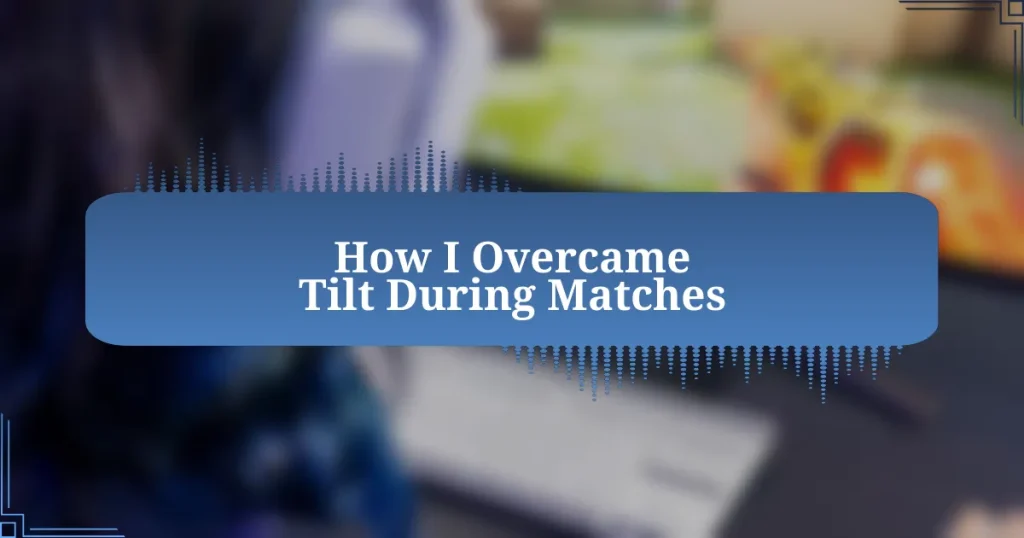Key takeaways:
- Tilt is an emotional state that negatively affects gaming performance, often stemming from unrealistic expectations and burnout.
- Recognizing signs of tilt, such as increased heart rate and negative communication, is crucial for regaining focus.
- Strategies to manage tilt include taking breaks, implementing pre-game rituals, and reframing losses as learning opportunities.
- Maintaining focus after tilt can be achieved through positive affirmations, visualization, and redirecting attention to controllable aspects of gameplay.
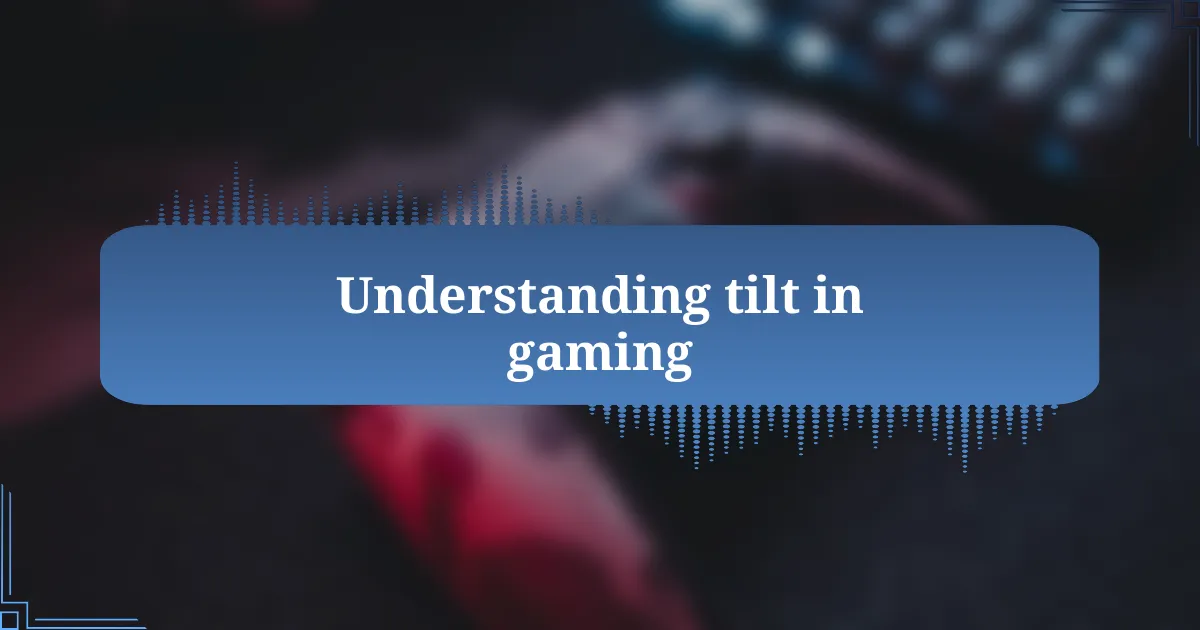
Understanding tilt in gaming
Tilt is a state of emotional frustration that can severely impact a player’s performance. I still remember a match where I missed an easy shot, and instead of shaking it off, I let that mistake spiral into a series of poor decisions. Have you ever had a moment where one error just makes everything feel worse, almost like it’s contagious?
Understanding tilt is essential because it can lead to a mental block, diminishing enjoyment and focus. I’ve experienced matches where, after succumbing to tilt, I found myself second-guessing every decision. It felt suffocating, like I was trapped in my own head, questioning whether I was even skilled enough to be there.
As I delved deeper into why I struggled with tilt, I realized it wasn’t just about gaming; it was about my expectations. I started asking myself what was at stake in those moments. Was winning really the only goal, or was it more about growth? Shifting my perspective on performance led me to find an entirely new level of resilience and enjoyment in the game.
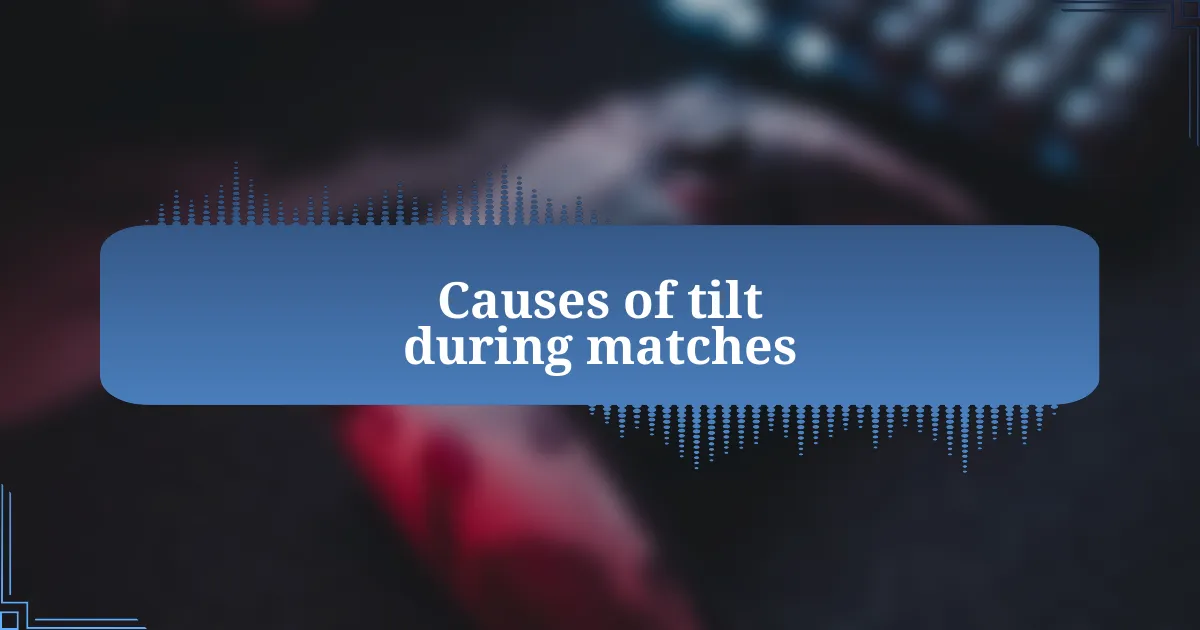
Causes of tilt during matches
Tilt can often stem from unrealistic expectations we set for ourselves. I remember vividly a game where I felt the pressure to perform because my friends were watching. That added weight made every mistake feel magnified, leading to a sense of urgency that only fueled my frustration. Have you felt that pressure too, where the stakes seemed higher just because of who was in the audience?
Another factor that contributes to tilt is the dynamic nature of team play. There were times when teammates made decisions I disagreed with, which sparked frustration within me. I found myself questioning their choices rather than focusing on my own performance. It’s a slippery slope; discontent can quickly shift from my gameplay to the team as a whole. Have you ever felt that disconnect in communication during a match?
Finally, burnout is a significant cause of tilt. I recall back-to-back gaming sessions where I neglected proper breaks, feeling mentally drained by the time I hit the next match. The sheer exhaustion made it hard to concentrate, and small errors led to explosive reactions. It made me wonder: How can we enjoy the game while pushing our limits without hitting that wall? Balancing practice and rest is essential; learning when to step away can truly be a game-changer.
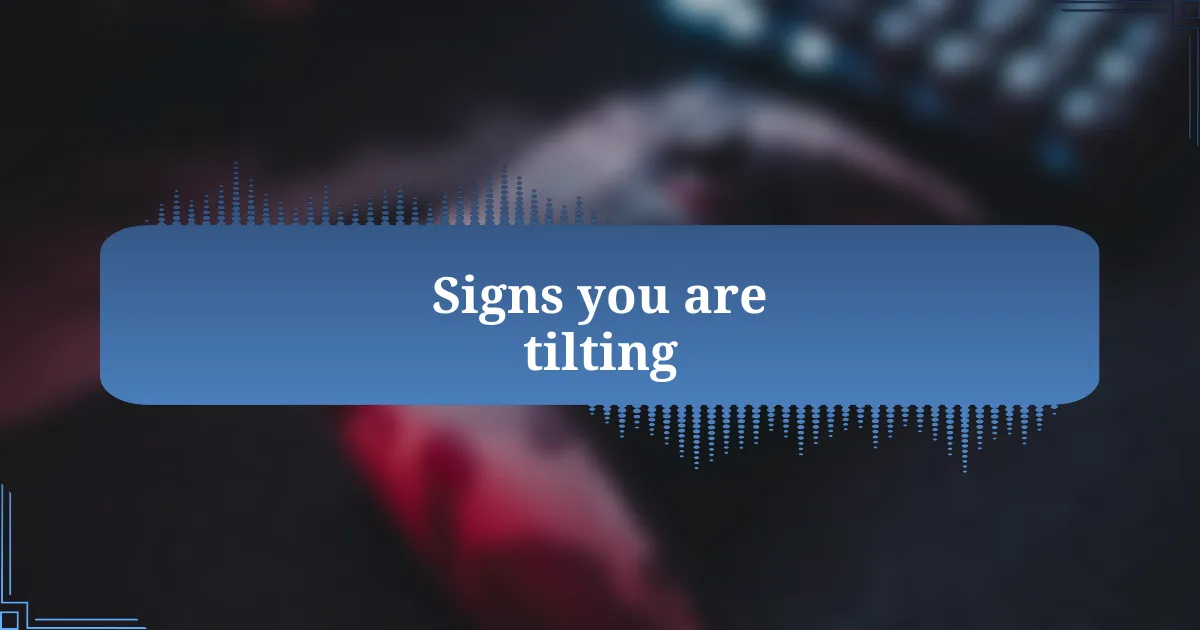
Signs you are tilting
It’s not always easy to recognize when tilt is creeping in, but certain signs are hard to ignore. For me, one of the first indicators was a sudden increase in my heart rate and a feeling of tightness in my chest. I would catch myself whispering frustrated remarks or even muttering under my breath after a bad round. Have you ever felt that rush, where every loss makes your frustration simmer just below the surface?
Another telltale sign of tilting is how I began to react to small mistakes. Typically, I could brush off a missed shot or a misplay, but when I was tilted, they felt like catastrophic failures. I’d get caught in a loop of self-criticism, replaying those moments in my mind and allowing them to cloud my thinking in the next rounds. It’s frustrating, isn’t it? Those moments should just be learning opportunities, but instead, they felt like anchors dragging me down.
I’ve also noticed that my in-game communication would start to morph when I was tilted. Instead of constructive feedback, I found myself sending snappy remarks or outright negativity towards teammates. One time, I snapped at someone for a tactical choice they made, and it made the whole team’s morale sink. It taught me that recognizing these shifts early can help steer the game back toward a positive direction. Have you experienced similar shifts in your communication when you weren’t at your best?

Strategies to manage tilt
When I noticed myself starting to tilt during matches, I found it crucial to take breaks. Stepping away from the screen, even if just for a few moments to grab a drink or stretch, had a surprising effect. It allowed me to clear my head and regain focus. Have you ever found that a short break can refresh your perspective?
Implementing pre-game rituals became another strategy for me. Whether it was listening to my favorite music, doing some deep breathing exercises, or visualizing success, these routines helped create a mental buffer against tilt. I remember one particular match where I felt unusually confident after a good warm-up, which countered the nerves that often led to in-game frustration. What do you think your mind needs to feel prepared for a match?
Perhaps one of the most effective techniques for managing tilt involved shifting my mindset regarding losses. Instead of viewing a defeat as a personal failure, I started seeing it as a crucial part of my growth in the game. After all, I’ve learned more from my losses than my wins. This perspective change helped me transform frustration into motivation, reducing the likelihood of tilting in the first place. How could a shift in attitude help you in your gameplay?

Personal experiences with tilt
I remember one match, the tension was palpable, and with every round we lost, my frustration mounted. In those moments, I could almost feel my hands clenching the mouse tighter, my heart racing. It’s like I was riding a roller coaster of emotions, and I had to remind myself that this game was supposed to be fun, not just a test of skill.
One evening, after a particularly brutal loss, I sat back and reflected on what had gone wrong. Instead of blaming my teammates, I decided to analyze my own gameplay. I realized I had been too focused on winning and not enough on learning. This epiphany shifted my entire approach going forward. Have you ever caught yourself holding onto blame when it might be time to look inward?
There was a time when I reacted impulsively to in-game moments, often grumbling about my teammates’ decisions. I vividly recall one match where I let a single bad call spiral into a series of mistakes on my part. Recognizing that I had the power to control my reactions, I learned to communicate more positively, fostering a better environment for us all. Reflecting on past experiences can be a powerful catalyst for change, don’t you think?
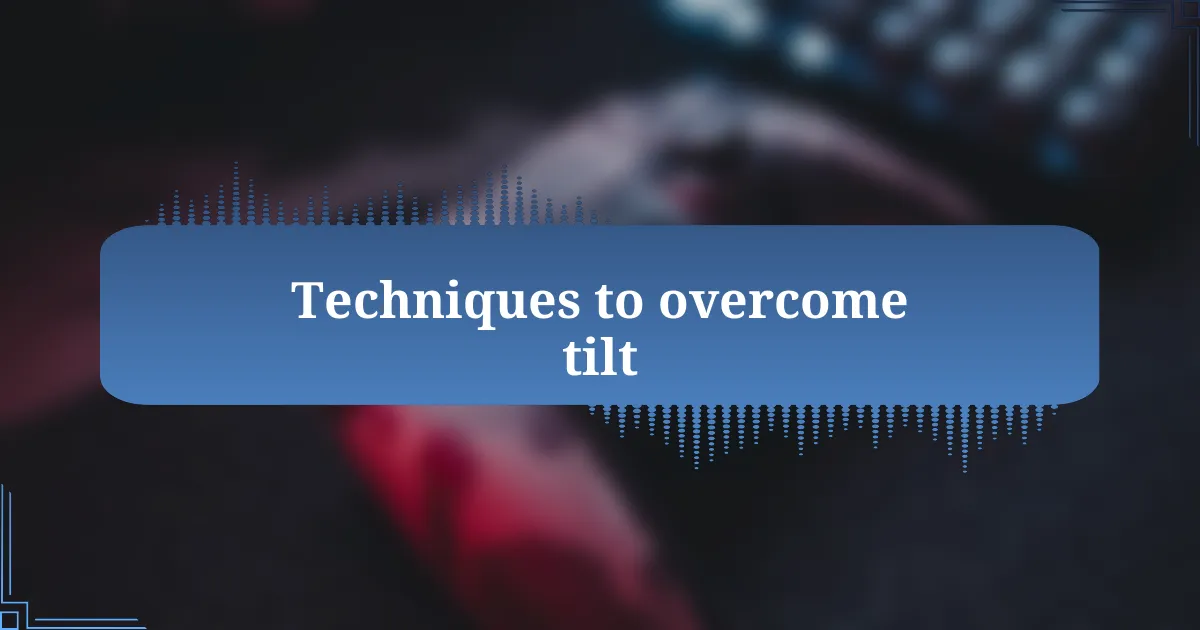
Techniques to overcome tilt
One technique that helped me combat tilt is the practice of deep breathing. Whenever I felt frustration bubbling up, I would take a moment to close my eyes and inhale deeply, counting to four, then exhale slowly. This simple act grounded me, helping to clear the clutter in my mind and regain focus. Have you ever noticed how a couple of breaths can shift your mentality?
Another strategy I found effective is setting small, realistic goals during matches. Instead of fixating on the overall outcome, I would tell myself to focus on achieving better kill-to-death ratios or improving my positioning. This change in perspective allowed me to celebrate minor victories, even amid losses. Isn’t it rewarding to shift the narrative from win/lose to little personal achievements?
When things really got tough, I found that taking a break was vital. After a few bad rounds, I’d step away from the game for a few minutes, sometimes grabbing a snack or just stretching. This distance offered me a fresh perspective when I returned, often leading to improved performance. Have you ever noticed how stepping back can give you a new lens on a problem?
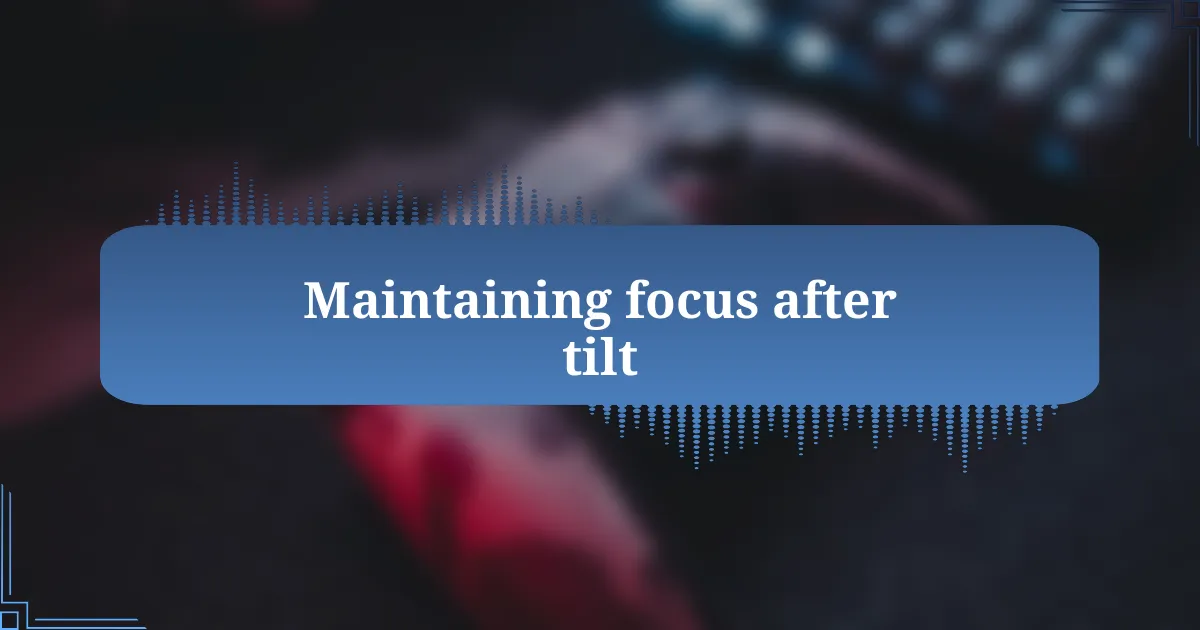
Maintaining focus after tilt
It’s amazing how easily our minds can drift into frustration during intense matches. After experiencing tilt, I found myself actively telling my brain to refocus by highlighting what I could control within the game. This approach made a significant difference — instead of being consumed by the mistakes of previous rounds, I shifted my attention to accurate crosshair placement or communicating better with my teammates. Have you ever realized how a minor change in focus can completely reshape your gameplay?
I also learned the value of using positive affirmations right after feeling tilted. Whenever I began to spiral into negativity, I’d remind myself of my skills and past performances — “I’ve made clutch plays before, and I can do it again.” By reinforcing my self-belief, I created a mental reset that helped me step back into the match with renewed confidence. Have you ever tried affirming your abilities in the heat of competition? It truly can pull you out of a slump.
Another technique I adopted was visualizing my next play while taking a moment to breathe. After a frustrating round, I would picture how I wanted to approach the next engagement, seeing each movement in my mind. This visualization not only prepared my mind but also brought my focus back to the game plan instead of past errors. How often do we let the echoes of previous mistakes dictate our next move? By imagining success, I could reclaim my mindset and push forward with determination.











